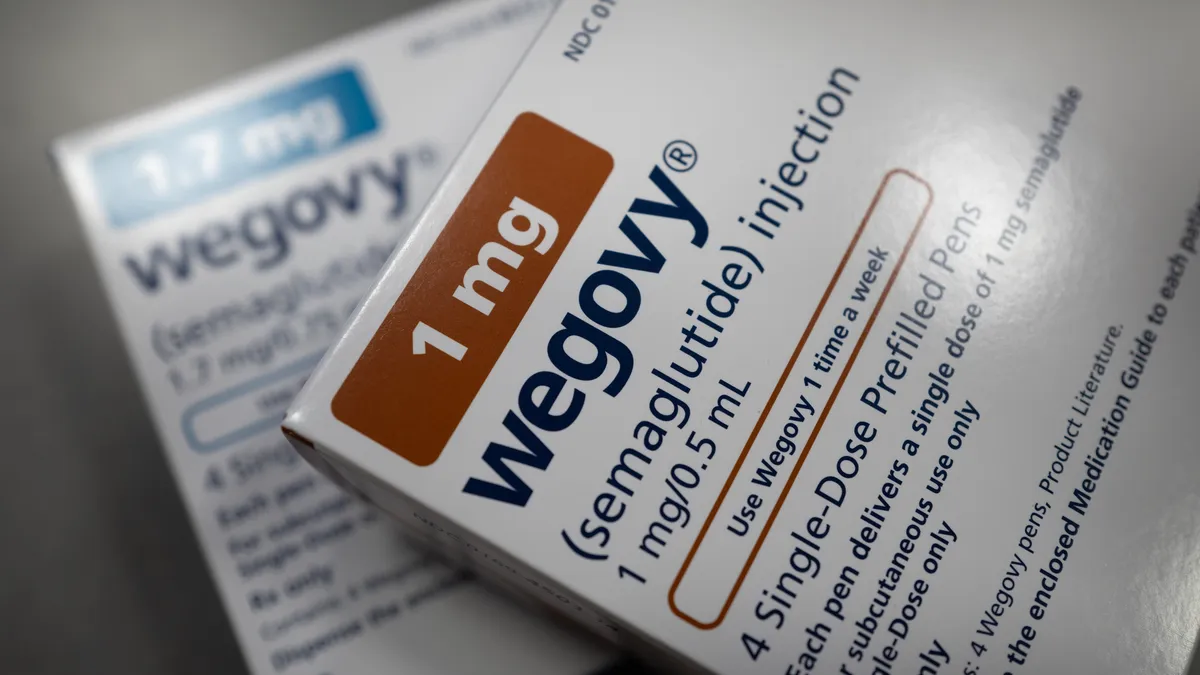Dive Brief:
- An expensive weight loss drug could become one of Medicare’s costliest medications, even if the majority of patients are ineligible for coverage, according to a study published Monday in the Annals of Internal Medicine.
- The analysis found 3.6 million people are likely to be eligible for treatment with semaglutide, a GLP-1 drug that’s approved as Wegovy to treat obesity and reduce heart risk. More liberal definitions of eligibility could increase that number to 15.2 million people.
- If all newly eligible patients received semaglutide, spending in Medicare’s Part D prescription drug benefit could increase by $34 billion to $145 billion each year, according to the study. Even if the government narrowly defined eligibility, federal spending on the medicine could still exceed $10 billion annually.
Dive Insight:
New GLP-1 drugs have shown great promise at treating obesity, a condition that affects a large proportion of American adults and contributes to a range of other health conditions. More recent testing has shown semaglutide, and a rival drug from Eli Lilly, hold notably other benefits.
In March, U.S. regulators approved Wegovy for expanded use reducing heart attack risk in people with cardiovascular disease and who are obese or overweight.
But Wegovy and drugs like it are costly and, at least for weight loss, people need to take them chronically — potentially putting strain on insurers should significant numbers of people receive treatment.
Employers, who provide health insurance coverage for the majority of Americans younger than 65 years, have already been sounding alarms over the drugs’ contribution to rising healthcare expenses.
A report published last week by the Business Group on Health estimates large employers are preparing for a 7.8% spike in healthcare costs next year, largely due to increased spending on pharmaceuticals like GLP-1s.
Meanwhile, Medicare spending on GLP-1 drugs has already accelerated. Gross spending on the medications rose from $57 million in 2018 to $5.7 billion in 2022, even though the program only covered three GLP-1 medications for diabetes at that time, according to an analysis by health policy research firm KFF.
But now more Medicare beneficiaries may be able to access semaglutide. This spring, the Centers for Medicare and Medicaid Services said it would cover the costs of Novo Nordisk’s Wegovy for some people with a history of heart disease. (Medicare is currently prohibited for covering medicines only for obesity.)
The new research aims to estimate how much covering semaglutide could cost Medicare, depending on how the program defines patients with established cardiovascular disease.
While more than 14% of Medicare-eligible adults would be highly likely to be covered for semaglutide, more liberal definitions of established cardiovascular disease could increase that proportion up to nearly 61%, according to the study.
Still, access to the drug could be impacted by other factors, like out-of-pocket costs, drug shortages, utilization management strategies and formulary placement, the researchers wrote. For example, if the medication is put on a specialty tier, Medicare Part D drug plans could charge 25% to 33% of the medication’s retail cost.
But even with low usage rates, the medication could potentially become one of the largest drivers of Medicare spending without near-term budget controls, according to the study.
Only 1 in 7 Medicare beneficiaries with elevated BMI are likely eligible for semaglutide if established cardiovascular disease is narrowly defined, researchers found. Even then, costs to Medicare could still exceed $10 billion each year.
“In this conservative coverage scenario, that means most beneficiaries with elevated BMI and cardiovascular risk would remain ineligible for semaglutide, yet the medication could still potentially become one of the costliest drugs to Medicare,” lead author Alexander Chaitoff said in a statement.















